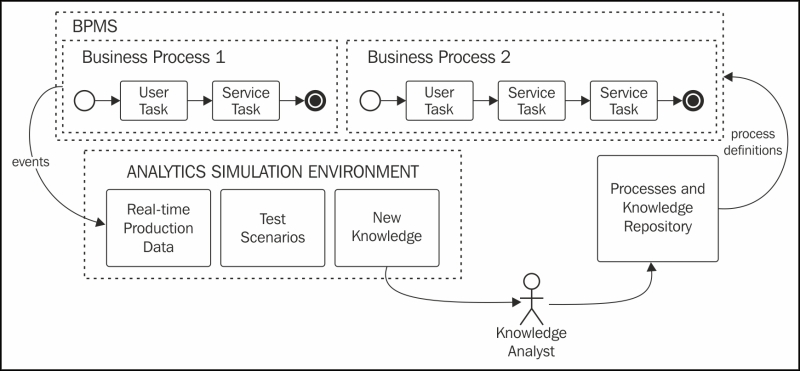Predictive analytics is a highly recurring concept that surrounds decision management systems. It is based on analyzing the information exposed by knowledge-based services and finding missing cases, detecting projections in the values of variables, and expanding the universe of information by cross-referencing other sources of information.
In order to analyze this information to obtain such insights, events from different sources (including process executions from BPM systems), that is, from real-time production environments, are fed into a simulation environment. Here, queries are raised and data analysis conducted to test different scenarios to see which ones have a better coverage of all the cases.
The information obtained is later used to feed new knowledge definitions to production environments. This cycle is known as the decision analysis cycle.

Decision analysis cycle, encompassing both runtime and analysis
BPM systems assist in decision management by providing a way to define business processes that are both very visual and faster to update than other system implementations. Of all the possible forms of quickly representing and adapting knowledge, business processes are the most descriptive way to provide a sequence of steps. They provide a great added value to the decision management software by allowing them to inject new process definitions to increase the number of decisions that can be taken or handled.
At the same time, decision management provides a great added value to BPM systems by providing feedback for a new process's discovery and analysis tools to detect cases not yet covered by processes, allowing process quality to be improved.
The analytics of production data is a very powerful tool that can be used in three different stages of the BPM cycle. In stage 5 (monitoring), it is involved in collecting information from runtime environments to create a data source for future investigation. In stage 6 (improvements), analytics is heavily involved in finding new cases not previously covered by the existing runtime. Finally, for stage 1 (discovery), simulation environments play a fundamental part in understanding the impact of new processes or modifications to existing processes in the real-time existing production environment.
At the moment, there aren't any tools inside the KIE suite to create these decision analytics directly, but new features are added constantly to the existing suite. So, I wouldn't be surprised if by the time this book is published, some form of tooling to do this analysis is introduced to the suite as a new experimental feature, probably as an add-on to be adopted in the future.

As you can see in the preceding figure, events from the BPM system can be fed to the decision software analysis tools, and the acquired information can be used to define new business processes or improve existing ones. Thanks to the simulation tools, new processes can be tested with existing data to see whether they will meet the discovered scenarios.
There is a lot more content regarding decision management software, and unfortunately we can't fit it all in this book. The tooling provided by jBPM6 can be connected to decision management in one way or another, and during the course of this book, whenever we start explaining each tool in detail, we will mention how it can connect to the decision management software. For the moment, let's just explain that it provides a methodology to provide fast and continuous improvement of knowledge definitions in order to drive smarter actions in all our systems (including our BPM systems).
